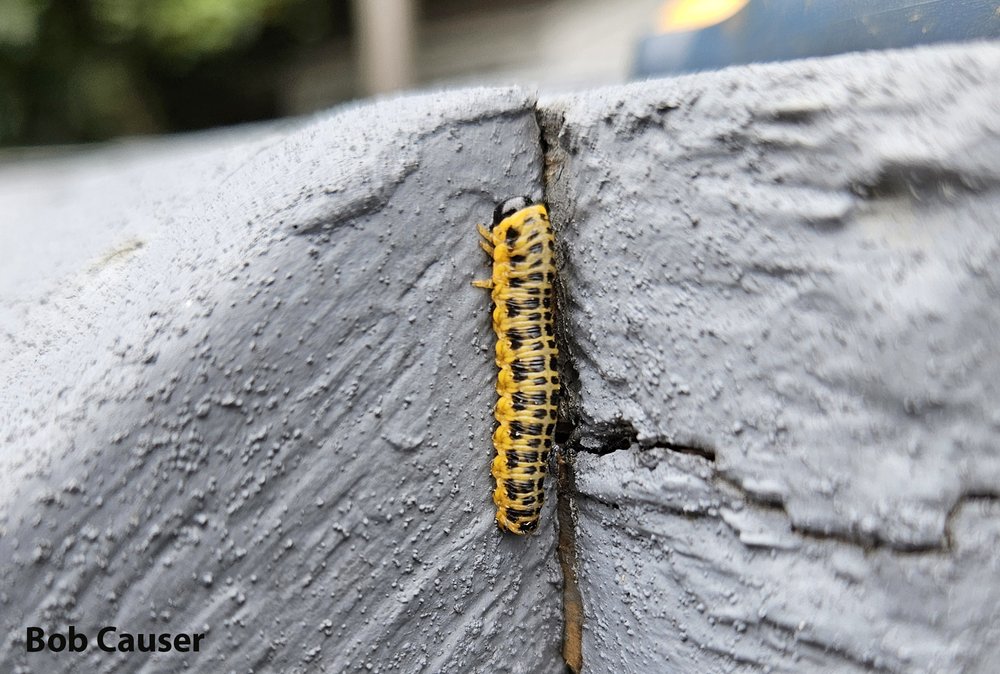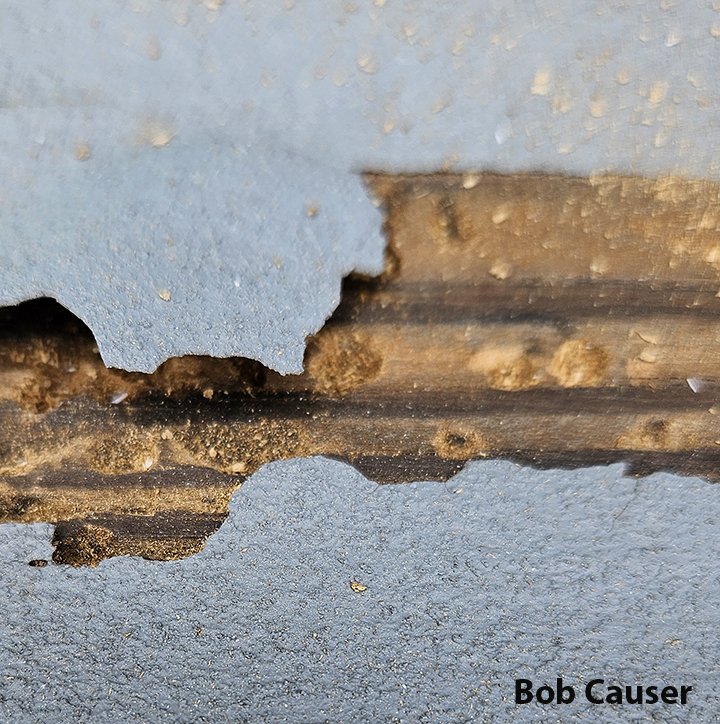
An almost fully developed dogwood sawfly larva checks out a deck to find the perfect spot to construct its winter refuge in wood. Image credit: Bob Causer

Several small pock marks reveal locations where dogwood sawflies attempted to construct overwintering galleries in a deck. Image: Bob Causer
Herbivorous insects are full of surprises. Who would have guessed that a leaf munching larva spends another part of its life cycle boring in wood to build a place to hang out in winter? Not me, but this is how the dogwood sawfly rolls. A few weeks ago, I received great images of a dogwood sawfly larva and a report that it was gnawing holes in a deck and generating piles of sawdust. Other encounters with sawflies here at Bug of the Week include ones with sawfly larvae munching on mallows, crushing columbines, and ravaging roses.
Sawflies are primitive members of the bee and wasp order of insects known as the Hymenoptera. Unlike their kin, who feast on the flesh of other arthropods or dine on the nectar and pollen of plants, several families of sawflies feed on leaves. One of the favored hosts of dogwood sawfly is grey dogwood, Cornus racemosa, but silky dogwood, Cornus amomum, and flowering dogwood, Cornus florida, are also on the menu. Dogwood sawfly larvae spend their summer devouring dogwood leaves, initially in chummy groups that skeletonize leaves, but as they grow larger, they may eat the entire leaf with the exception of the midvein. Winter is spent as a larva ensconced in a chamber, or “cell”, built in rotting wood or sometimes structural wood including siding, or as in the case of this week’s star, decks.
Early in their development dogwood sawflies like the one on the right are cloaked in white wax. Later they lose their wax. Watch as these snaky sawflies practice their curls beneath a leaf. An almost fully developed larva waves to the camera while searching for another meal. In autumn before leaf-fall, they build galleries in wood to spend the winter. Notches in this deck bear witness to their attempts.

An easy way to tell the difference between caterpillars (the larvae of moths and butterflies) and sawfly larvae, is to count the pairs of appendages called prolegs on their abdominal segments. Caterpillars like the larva on top have five or fewer pairs of prolegs. Sawfly larvae like the one below usually have six or more pairs of prolegs.
In spring, the larvae pupate and adults, resembling small wasp-like insects, emerge to fly and find mates from May through July. Females insert their eggs in the undersurface of dogwood leaves in batches numbering 100 or more. Eggs hatch and larvae consume leaf tissue and develop through several growth stages, or instars, over the summer. With the approach of autumn and imminent leaf drop, large mature sawfly larvae wander from dogwood trees to construct overwintering redoubts in wood. Although many sawfly larvae bear a striking resemblance to caterpillars, larvae of moths and butterflies, most can be distinguished from Lepidoptera larvae by the number of pairs of appendages called prolegs found on abdominal body segments. In addition to three pairs of jointed walking legs on the thorax, most caterpillars have five or fewer pairs of fleshy prolegs on their abdominal segments. By contrast, in addition to the requisite three pairs of thoracic legs, most sawflies bear six or more pairs of prolegs.

Beautiful dogwood sawfly caterpillars assume their characteristic curly pose between bouts of defoliating dogwoods.
As larvae, dogwood sawflies have, quite literally, a colorful juvenile history. After hatching from eggs, larvae are rather translucent yellowish creatures resembling gummy worms. As they develop and molt, specialized glands produce a snowy-white cloak of wax. Fully developed larvae shed the white waxy cloak and assume a dashing color scheme of yellow, white, and black. Why the chameleon routine? Well, some scientists have speculated that the brilliant white coloration and elongated body of young larvae may mimic a bird dropping and reduce the chance of predation. What self-respecting bird eats bird droppings, right? Another hypothesis suggests predators and small parasitic wasps may be unable or unwilling to effectively attack sawfly larvae through their cloak of wax. As dogwoods get ready to shed their leaves in the next few weeks, keep an eye out for these beautiful and interesting creatures.
Acknowledgements
Bug of the week thanks Bob Causer and Virginia Brace for providing images and inspiration for this episode. Thanks also to our friend Jimmy who shared his dogwood and its sawflies. The interesting articles “Be Alert for Dogwood Sawfly” by Joe Boggs, and “Insects that feed on trees and shrubs” by Warren Johnson and Howard Lyon were used as sources of information for this story.
No comments:
Post a Comment